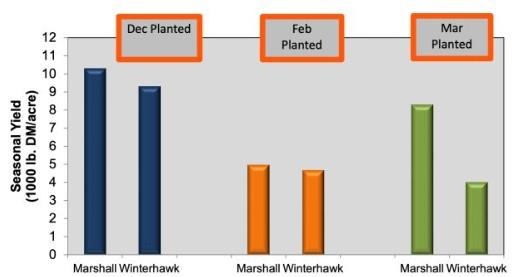Results

Figure 1. Seasonal yield of late-planted annual ryegrass varieties.
Seasonal yield (figure 1) was greatest for the Marshall and Winterhawk ryegrass that was planted in December. March-planted Marshall ryegrass was intermediate in production compared to varieties planted in December, while February plantings and the March-planted Winterhawk ryegrass had the lowest seasonal production.
Overall ryegrass yield was between 4,000 and 11,000 lb. of dry matter per acre across planting dates. The combination of relatively mild climatic conditions and adequate rainfall after each planting date supported favorable growing conditions for ryegrass in this study (table 1). Frost events occurred largely in early January and again in mid-February. February ryegrass plantings were most affected by frost timing, and yield was more negatively impacted than the December or March plantings.
Grazing was initiated on December-planted pastures during the last week of March, whereas February and March planting dates were unable to be grazed until early May.
Forage nutritive value of annual ryegrass was greatest at the beginning of the grazing season in March and declined rapidly with increasing maturity through June. Decreasing forage quality corresponds with a rapid increase in forage yield that was observed in late April through June (table 2).
Table 1. Average Monthly Temperature and Rainfall from December 2016 through June 2017
Table 2. Forage Nutritive Value of Annual Ryegrass Varieties (% Dry Matter Basis) Planted from December 2016 through March 2017
Summary
During the one-year evaluation, late-planted annual ryegrass provided adequate forage dry matter production to support late-spring grazing. Mild climatic conditions during the winter allowed for successful establishment of annual ryegrass in this demonstration project. However, year-to-year variation in temperature and frost events can greatly influence production and stand health, increasing production risk with late-planting cool-season annuals. Planting cool-season annuals late should only be considered in drought years or after severe winter kill/damage as a source of emergency forage.
Source : aces.edu